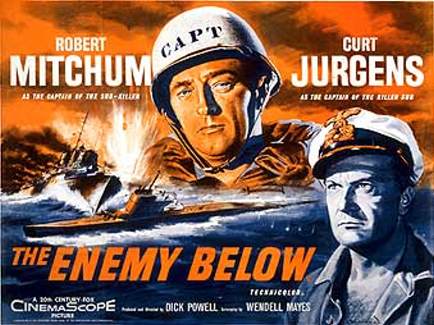
THE ENEMY BELOW
US, 1957, 98 minutes, Colour.
Robert Mitchum, Curt Jurgens, David Hedison, Theodore Bikel.
Directed by Dick Powell.
The Enemy Below is an interesting World War Two film. It is particularly interesting insofar as it was released in 1957 and looks at Germans and Americans equally. Robert Mitchum is the captain of the American destroyer who has experienced the loss of his wife in a torpedo attack. Kurt Jurgens is the German captain of the U-boat, not a Nazi, but devoted to his fatherland.
The screenplay has an amount of dialogue between the two captains illustrating their particular stances.
In terms of an action film, the film is a cat-and-mouse story with each captain stalking the other for final victory.
The film was directed by Dick Powell, better known as a singer and dancer in the 1930s and as a private eye-style actor in film noir of the 1940s. While he directed a great deal of television material, he directed six films including The Conqueror with John Wayne. His final film, made after The Enemy Below, was The Hunters, another World War Two story about aerial combat and pilots. It also starred Robert Mitchum.
The film was written by Wendell Mayes, a prolific Hollywood writer whose credits include Advise and Consent, Von Ryan’s Express, The Poseidon Adventure.
1. The focus of the title on Americans and Germans? The stating of a point of view In the title? How entertaining and interesting a film?
2, How typical a war film? Made in the late fifties? Its purpose in being made at this time? Memories of the war? Now?
3. The use of colour, Cinemascope? The locations of the American ship and our getting to know it well, the same with the German submarine? The atmosphere of the sea? The special war effects with the torpedoes, the explosions, the final destruction of both ship and submarine? Audience Interest in this kind of war film?
4. The importance of the structure of the film, the establishing of the American ship, Its personnel, the captain and the sailors, attitude towards him, their lack of trust? the intertwining with the presentation of the German submarine, the men and their way of life in the submarine, the captain and his men's loyalty to him? How well did the film continue to parallel both ships and both captains? The building up of the strategy and each anticipating the other? Success and flaws? Audience involvement in the manoeuvres of both? Sympathies for the Americans, the eliciting of sympathy for the Germans? The irony of their being brought together and showing the futility of the war by the mutual destruction of these two ships?
5. How well did the film delineate both captains? Robert Mitchum and his laconic American style, his way of command, the risks he took in strategy, his men's respect for him? The inevitability of his final mistake? The German captain’s respect for him? his respect for the German captain? The German captain's strategy, command over his men, loyalty of his assistant? His attitude towards Germany, to the Nazis? The portrayal of the men under them and the varying attitudes, qualities of human nature, conflicts, fear, patriotism?
6. How well did the film portray the difficulties In the mutual tracking, the details of the strategy? The building up of suspense? Waiting, tracking, firing?
7. How well did the film handle the emotional crises and as well as the war crises?
8. How impressive was the resolution of the film with the mutual help given by each captain? The saving of life after such destruction? Indications of the futility of war? A satisfactory war film,
a satisfactory anti-war film?